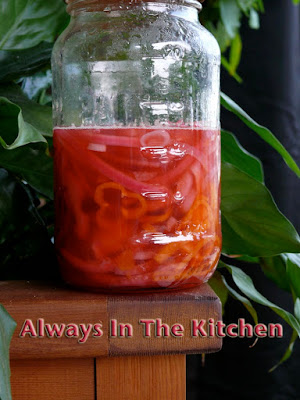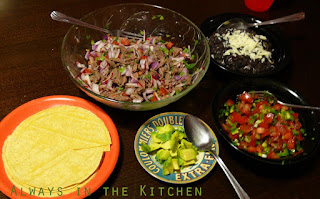
This is based on a Mayan recipe for a very simple black bean soup with big, striking flavours. It is easy to cook the beans the day before, and start from there. It is quite filling as a main dish, but half-sized portions make a terrific starter. The soup shown in the picture above includes finely diced ham, which is a purely optional add-in to a recipe that is otherwise completely plant-based.
Black Bean Soup
Serves 4
1 cup dried black beans (no need to soak)
water to cover beans
5 cups water (extra) or stock of your choice
2 tablespoons canola or corn oil
1 onion, finely chopped
2 cloves garlic, chopped or pressed
1 teaspoon dried pequin (aka piquín) chiles, crushed
1 medium or large tomato, peeled, seeded & diced
1/2 teaspoon dried epazote
1/2 teaspoon cumin
1/4 cup dry sherry
salt
Freshly ground black pepper
cilantro to garnish
Part 1 - Cook the beans
Rinse the beans well - you don't want grit or dust in your finished dish. Also give them a quick look-over to make sure there aren't any cunningly disguised little rocks in there - sometimes you find little tiny stones or other debris in dried beans.
Cover the rinsed beans with fresh water, up to about 5 centimetres above the beans. Bring to a gentle simmer and cook until the beans are quite tender, stirring occasionally. This can take as little as an hour or as long as two or two and a half hours, depending on how old your beans are. Play it by ear, but don't let the beans boil hard, or they will split and turn quite mushy. Most of the time, I find that dried black beans are ready in just one hour. Once the beans are tender, you can add a little salt - if you will be using stock in the second part, make sure you don't over-salt at this stage. You can also skip salt entirely until Part 2 and then adjust to taste. Note that if you have hard water (or beans of dubious age), a scant pinch of baking soda added to the water when you begin to cook the beans will help soften them more quickly. You can make the beans a day ahead, and then proceed from this point when you want to serve them. If you will be making the soup at a later date, allow the beans to cool and then refrigerate in their cooking liquid. Once they are completely cold, you can freeze them if you like.
Part 2 - Make the soup
If you are making the soup straight away after cooking the beans, you can prepare and sauté the vegetables while the beans simmer in Part 1 above.
Remove two thirds of the beans to a blender or food processor and puree. If you have an immersion blender, you can certainly use it right in the pot, but in that case you will want to remove about a third of the whole beans before pureeing (they will be stirred back in later, after the vegetables are added).
In a medium frying pan, preheated over medium heat, heat the oil and sauté the finely chopped onion, chopped garlic, and the pequin chiles until the onion is soft. Add the prepared diced tomato, epazote and cumin and stir until well blended. Add the onion mixture to the black bean purée and purée the mixture again until as smooth as possible. Combine the whole beans and the puréed mixture in the soup pot and add the five cups of extra water (or stock) and simmer gently, stirring frequently until the soup thickens and its components integrate. This takes only about five to ten minutes, in my experience.
If you want an even heartier soup, you could at this point add smoked tofu, diced ham, or diced chicken, as you wish, and simmer gently to heat the new additions through, stirring frequently. Remove any thick stems from the epazote that might have escaped the food processor. Add the sherry and stir through. Taste the soup and add more salt if needed, and it's ready to serve. Add cilantro to individual servings, or substitute finely sliced green onion if preferred.
I like to serve this with crispy baked flour tortilla-crackers, and sometimes a drizzle of contrasting hot sauce to add brightness. You can also top the soup with a scoop of salsa (preferably not cold from the fridge).
The soup also freezes very well, as do the cooked beans from Part 1.





























